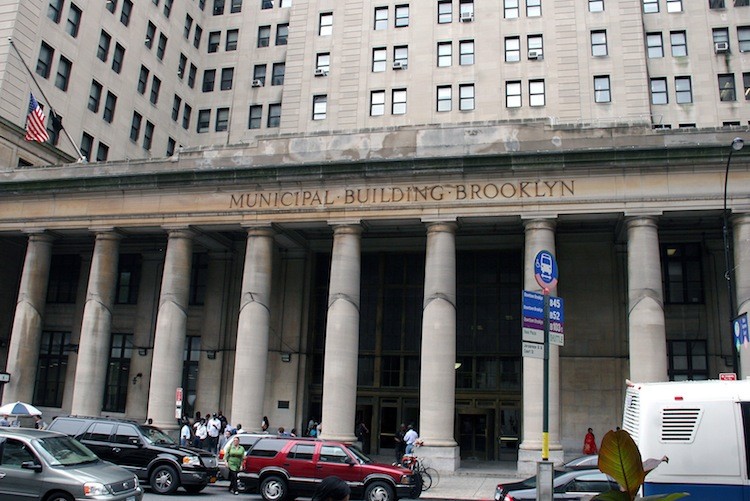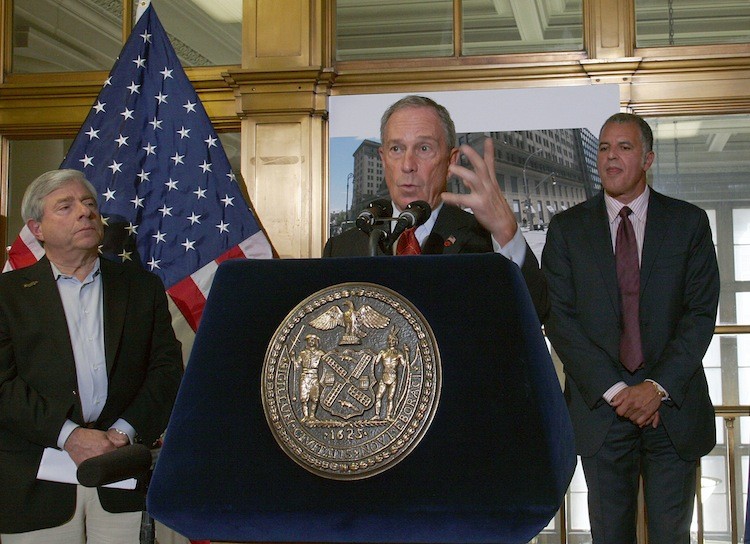NEW YORK—The Department of Finance (DOF) will move out of the Brooklyn Municipal Building, creating space for new retail stores as well as a full-service restaurant; a move that elected officials say will bring increased foot traffic and add night life to the downtown Brooklyn scene.
“This is really a bellwether day for downtown Brooklyn and the revitalization of downtown Brooklyn,” said Councilman Steven Levin, who represents the district. “What this really shows to me is that the growth of downtown Brooklyn is continuing unabatedly.”
The Brooklyn Municipal Building will open four or five stores with a “sprinkling” of diversity, but no banks or bookstores, said Albert Laboz of developer United American Land (UAL), and who is also chairman of the Fulton Street Mall and executive member of the Downtown Brooklyn Partnership.
There will be a full-service restaurant, and a separate entrance on Court Street to the businesses in the 13-story, 383,000-square-foot structure built in 1925, so customers will not have to go through a security check before shopping. Which restaurants and stores will be approved is still being decided.
The building is next to the Brooklyn Borough Hall and there are 14 subway lines and 16 buses nearby. UAL purchased the space inside the Municipal Hall for $10 million.
Consolidating the DOF into their four other offices is part of a city initiative, announced in the 2010 State of the City Speech, to use the space it owns and leases more efficiently.
“This is really a bellwether day for downtown Brooklyn and the revitalization of downtown Brooklyn,” said Councilman Steven Levin, who represents the district. “What this really shows to me is that the growth of downtown Brooklyn is continuing unabatedly.”
The Brooklyn Municipal Building will open four or five stores with a “sprinkling” of diversity, but no banks or bookstores, said Albert Laboz of developer United American Land (UAL), and who is also chairman of the Fulton Street Mall and executive member of the Downtown Brooklyn Partnership.
There will be a full-service restaurant, and a separate entrance on Court Street to the businesses in the 13-story, 383,000-square-foot structure built in 1925, so customers will not have to go through a security check before shopping. Which restaurants and stores will be approved is still being decided.
The building is next to the Brooklyn Borough Hall and there are 14 subway lines and 16 buses nearby. UAL purchased the space inside the Municipal Hall for $10 million.
Consolidating the DOF into their four other offices is part of a city initiative, announced in the 2010 State of the City Speech, to use the space it owns and leases more efficiently.
Over the past five years, around $3.4 billion in new private investment has been attracted to the area, in addition to $200 million in public funds, according to Mayor Bloomberg. That has turned into thousands of new jobs and almost 8 million square feet in new development.
Nearby is the Fulton Street Mall, a group of businesses that is “one of the most successful retail streets in New York City,” according to a Streetsblog.org article. One of the reasons behind the success is the accessibility to the area for pedestrians and transit riders due to the initial design being influenced by a lack of city funds. Subsequent federal transportation grants were used to link the area to transit, and the design changed “from one intended to compete with Long Island shopping malls into one that embraced its downtown Brooklyn location.”
Overall, with improvements in the area, officials joked that they hoped people would find time to visit Manhattan when they’re visiting downtown Brooklyn, implying that the outer borough is gaining ground on the traditional destination in sectors like shopping, residential, and tourism.
“Brooklyn is not only blooming, it’s blossoming, and for many of us there’s less and less need for us to go into Manhattan,” said Assemblywoman Joan Millman.
“New retailers are moving, intent on catching up with the area’s exploding population,” said Bloomberg. “Household names like H&M, Gap, and Shake Shack are in the process of opening their doors.”
Downtown Brooklyn is “one of the fastest growing neighborhoods in the city of New York,” said Bloomberg, and there has been more than 6,500 mixed housing units constructed over the past five years, while around 12,000 people now live within the 25-square-block area in the downtown.
Rezoned in 2004, more than 150,000 shoppers visit downtown Brooklyn daily and it is home to more than 100,000 office workers, over 40 arts and cultural organizations, and eight universities educating around 57,000 students.
Nearby is the Fulton Street Mall, a group of businesses that is “one of the most successful retail streets in New York City,” according to a Streetsblog.org article. One of the reasons behind the success is the accessibility to the area for pedestrians and transit riders due to the initial design being influenced by a lack of city funds. Subsequent federal transportation grants were used to link the area to transit, and the design changed “from one intended to compete with Long Island shopping malls into one that embraced its downtown Brooklyn location.”
Overall, with improvements in the area, officials joked that they hoped people would find time to visit Manhattan when they’re visiting downtown Brooklyn, implying that the outer borough is gaining ground on the traditional destination in sectors like shopping, residential, and tourism.
“Brooklyn is not only blooming, it’s blossoming, and for many of us there’s less and less need for us to go into Manhattan,” said Assemblywoman Joan Millman.
“New retailers are moving, intent on catching up with the area’s exploding population,” said Bloomberg. “Household names like H&M, Gap, and Shake Shack are in the process of opening their doors.”
Downtown Brooklyn is “one of the fastest growing neighborhoods in the city of New York,” said Bloomberg, and there has been more than 6,500 mixed housing units constructed over the past five years, while around 12,000 people now live within the 25-square-block area in the downtown.
Rezoned in 2004, more than 150,000 shoppers visit downtown Brooklyn daily and it is home to more than 100,000 office workers, over 40 arts and cultural organizations, and eight universities educating around 57,000 students.









